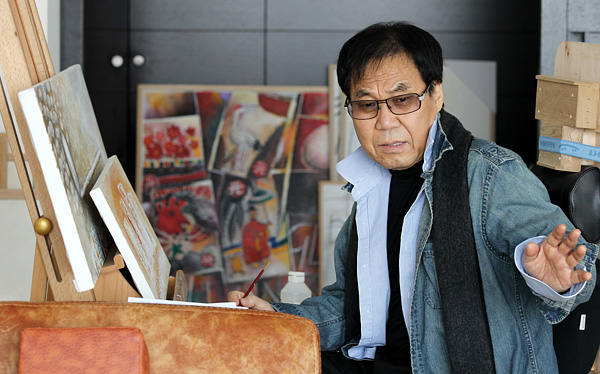Celebrity painter accused of outsourcing his art

Cho Young-nam discusses his life as an artist in February 2011 during an interview with the JoongAng Ilbo at his house in Gangnam District, southern Seoul. [JOONGANG PHOTO]
The announcement by prosecutors in Sokcho, Gangwon, came a day after they raided Cho’s office and art studios in response to a report last month by a man who claimed he had been painting on Cho’s behalf, doing most of the work and receiving only 10 percent of the proceeds.
It remains unclear how many pieces Cho may have sold under the arrangement, to whom and for how much, but prosecutors are investigating.
Sources in the local art industry who have knowledge of Cho’s work said his paintings usually sell for millions of won and up to tens of millions of won.
In a February 2011 interview with Ilgan Sports, an affiliate of the Korea JoongAng Daily, Cho said an eight-painting collection had sold for 800 million won ($680,000).
The alleged outsourcing of Cho’s paintings was picked up by prosecutors in Sokcho, 130 miles east of Seoul, when a 60-year-old artist there claimed last month that he has painted around 300 pieces for Cho over the past eight years.
Prosecutors quoted the man as saying he paints 90 percent of a work, allowing the singer to finish it and sign it. The man said Cho would give him a draft and order several copies.
The paintings were mostly inspired by hwatu, a Korean card game also known as Go-Stop.
Prosecutors said the ghost-painter came clean out of a guilty conscience, adding that he claimed to refuse to paint for Cho at one point for a period of a year.
The authority put weight on text messages exchanged between Cho’s manager and the ghost-painter that show the manager naming titles of paintings and explicitly ordering him to paint more of them.
In an exclusive telephone interview with the JoongAng Ilbo on Monday, Cho adamantly denied any wrongdoing, asserting that “all artists have assistants” and that the 60-year-old was one of a few.
“An assistant is someone who helps me because I can’t find enough time,” Cho was quoted as saying. “An assistant is someone who does as I say. I show a sample, and [the assistant] creates the same thing.”
When asked how much his paintings sold for, Cho refused to reply, insisting he did his assistant a favor by giving him work and paying him part of the sales.
“I ordered him to paint all kinds of miscellaneous paintings, knowing he can’t earn a living without me giving him work,” Cho said. “He’s now caused trouble.”
While details of Cho’s assistant remain largely opaque, the JoongAng Ilbo has described him as an artist who worked for 28 years in the United States after earning an art degree from an American college.
He returned to Korea in 2008 and got in touch with Cho.
Prosecutors have yet to announce any plans to summon Cho for questioning but said the time will come.
Critics from the local art industry have responded with mixed reactions, with many highlighting the prevalence of outsourcing artworks in Korea.
An artist in Daegu, who requested anonymity for this article, said the practice was so common that many of his colleagues refer to it as “operating a factory.”
“It means that a renowned artist who sells his work at an expensive price does so by hiring unknown artists or college students majoring in art,” the source said.
The process allows them to have many pieces worked on simultaneously.
“There have always been rumors that celebrated artists in Korea run their own factories,” he said. “It is not only Cho.”
Chin Jung-kwon, a culture critic and professor of liberal arts at Dongyang University in Yeongju, North Gyeongsang, said on his Twitter account that the prosecution’s investigation into Cho was an “overaction.”
“It might sound weird,” Chin wrote Tuesday, “but after the emergence of conceptual art and pop art, it has actually been very common for an artist to suggest the concept [of an artwork] and have someone else physically carry it out.”
He added that “the kernel is the concept, and who provided it; if Cho Young-nam was the one who did so, it wouldn’t be a problem.”
Chin also said in his tweet that the cut Cho’s assistant received was “too cheap.”
Cho has an exhibition at Gallery UHM in Yongsan District, central Seoul, that opens on Thursday for three weeks.
BY LEE SUNG-EUN, JUNG JAE-SUK [lee.sungeun@joongang.co.kr]










with the Korea JoongAng Daily
To write comments, please log in to one of the accounts.
Standards Board Policy (0/250자)